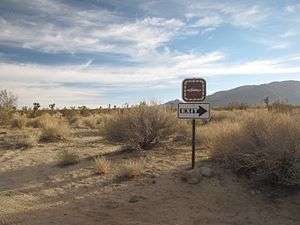Arid region safety
An arid region has little or no precipitation. These hot, dry areas present particular hazards to the traveller.
- This article deals with 'hot' arid regions. For safety in areas made arid by cold temperatures, see Snow safety, Ice safety and Cold weather.
Understand

Arid regions are those where the rainfall is very low, and consequently little surface moisture may exist. Major arid regions can be found around the world in North America, South America, Africa, Asia and Australia, and are commonly also referred to as deserts.
Arid regions typically lack large human settlements, and can be a great place to observe an unspoilt natural environment. Given the lack of water, these areas can also be very dangerous and good preparation is required.
Prepare

Travel in arid regions requires careful planning.
Things to check carefully are:
- Are you physically fit enough to cope? Prolonged exposure to the hot conditions, can aggravate certain medical conditions due to heat-stress. For someone from a relatively cool climate, the sudden impact of a hot climate can be startling. Consider spending a few days in a location where you can safely acclimatise, before venturing into the desert.
- Is your selected transport mode reliable? Get your vehicle checked beforehand, even if you will be using paved roads. Make sure that it's not only fully fuelled, but also has plenty of radiator coolant and oil, and that you have the appropriate "spares". In remoter regions, consider taking more than one vehicle, even when you do not need the space. If you are travelling alone, then consider arranging a convoy with other travellers.
- Do you have a way of contacting the outside? Many arid regions are sparsely populated and coverage of certain communication networks may be patchy. A cellular phone may well be out of range! Familiarity with two-way radio equipment or a satellite phone is strongly advised.
- Do you know where you are going, how long it will take and what alternative routes you have? Visiting an arid region needs navigational planning in advance, there may be hazards specific to an intended route. Try not to be complacent. Heeding advice from locals in the region you intended to visit prior to a trip is highly advisable. Engaging a responsible guide should also be considered.
- Will you know where you are? Consider carrying a GPS device, or adding one to your phone or vehicle, both because it will help you navigate safely and because it will let you tell rescuers where you are if an emergency develops. You should also have a printed map/compass and know how to use them.
- Will the outside know where you are? Leave details of where you are going with someone. This should include both your planned route (and potential alternate exit routes) and also the time when you expect to return.
What to pack
- Water. At minimum, you should allow 6–8L (1.5–2 gallons) per person per day, but if it's hot or if you are doing extensive physical activity, considerably more water may be needed. Remember to allow extra for emergencies. Also consider that electrolyte levels need to be maintained. Sodium, potassium, calcium, magnesium, iodine, and other minerals are lost through sweating. They can be replenished through eating fruits, vegetables, and salty foods. Sports drinks tend to be weak on potassium and iodine but can be helpful. Some people sweat more than others, and some people's sweat is saltier than others. If your clothes develop white, salty marks when you've been sweating, then your body loses more sodium and other salts than the average person. Especially if you aren't used to a hot, dry climate, your body will sweat more and may lose more salts than usual, especially during your first week in this climate.
- Fuel for you. Do you have enough supplies? Water is already mentioned, but don't forget that you need food for yourself. Bring more than you think you will need.
- Loose, light-colored clothing. Wear lightweight, long-sleeved clothes, and a wide-brimmed hat to protect yourself from wind, sun, and heat. Wear sunglasses. Use a generous amount of sun screen, and reapply it several times each day. A sunburn can be painful, and in an arid environment, it can also make you more susceptible to dehydration and serious medical complications such as heat stroke and kidney failure.
- Sun protection. In an arid region, the daytime sun can be relentless.
- Warm clothing. some desert environments can become very cold after sunset
- A signal method for emergencies. A radio or satellite phone is great, but consider taking an old-school method that doesn't depend upon electricity as well, such as a whistle, signal mirror, flares, or matches to start a signal fire.
- A first-aid kit. What you'll need depends upon what you're doing. Backpackers will need moleskin or other methods for dealing with blisters, while someone driving on a highway might not.
- Fuel for your vehicles. It's a good idea to take some extra gasoline, coolant, and oil.
- Self-rescue equipment. In case your vehicle gets stuck or you need to fix a flat tire, you should also take a high-lift jack, a tow chain, boards or mats for getting out of the sand, and a shovel.
- Maps, Compass and GPS devices. You don't want to get lost.
Navigate

A GPS device is strongly advised. Even a simple compass should be a standard item. Take a map, even if you intend to use an electrical device as your primary navigation method.
Even if using a compass or GPS, check an intended heading at regular intervals. Diverging from a heading is easy when there are few obvious or familiar landmarks. Two items of vegetation can be confusingly similar, and to the untrained, two rock formations can be equally identical.
Plan your route carefully, and don't try to do much in one day.
In remoter regions, consider hiring a local guide, or at the very least take local advice seriously.
Stay safe
Arid regions may host dangerous wildlife, especially snakes and scorpions. Be careful where you step, and shake out your boots before putting them on. Stay away from desert wildlife, even if it seems safe or familiar. An encounter with a swarm of bees can ruin any trip.
Although arid regions are largely dry, when it does rain, conditions will change rapidly. Flash floods can rise seemingly from nowhere. Never camp or park in a gully, wadi, or any low, stream-shaped space, even if you don't think it will rain in your area.
Also do not be misled into thinking that 'heat' in the day applies at night. Many arid regions can become considerably cooler at night; in some, even frosts are possible.
If in a vehicle, drive for the conditions. If driving off-road, watch for sudden changes in the terrain or surface firmness. Strictly avoid areas around abandoned mines, sinkholes, and other hazards.
In certain areas, including expanses of sand or surfaced roads, mirages can easily form under the hot conditions. These are a form of heat haze or shimmer, that can give a distant object the apparent appearance of being viewed on a water like surface. A mirage can also make it appear you are seeing a distant lake or shore, when no such body of water exists. All are optical illusions, there is no water present in these circumstances. Do not be fooled!
In some arid regions, the local population will be prepared to offer advice, specific to that region. The traveller would do well to discreetly take heed of it when it's offered.
Deserts are not necessarily well policed, and can be home to criminal or terrorist groups. Check any relevant travel advisories carefully.
Stay healthy
- Drink water frequently, even when you don't feel thirsty. You can get dehydrated even when not sweating. Try and drink at least one cup of water every hour, in addition to the water you drink with meals.
- Watch for the symptoms of heat stress, such as confusion, dizziness, nausea or a headache. If you or fellow travellers have these, it's time to get in the shade, drink some water and take the time to cool down. Dampening clothing can also help, but don't overdo it.
- It is a dangerous myth that water can be obtained from cacti, which in any case are native only to the Americas; drinking from unknown plants could cause more harm than good.
If you get stuck
If in a vehicle, stay with it. A vehicle is easier to spot than a lone traveller. Abandoning a vehicle, if even considered, should be an absolute last resort. If you have to leave it, then leave details at the vehicle concerning your intended plans, including the date and time of your departure, which direction you're heading, and how you'll mark your trail.
Temporary shelter and shade are priorities, as is safe water. If you have spare water, drink it sensibly.